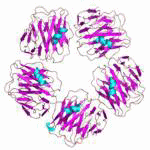Molecular Biology
|
21 november 2019 20:00:43 |
| IJMS, Vol. 20, Pages 5854: In Human and Mouse Spino-Cerebellar Tissue, Ataxin-2 Expansion Affects Ceramide-Sphingomyelin Metabolism (International Journal of Molecular Sciences) |
|
Tweet Ataxin-2 (human gene symbol ATXN2) acts during stress responses, modulating mRNA translation and nutrient metabolism. Ataxin-2 knockout mice exhibit progressive obesity, dyslipidemia, and insulin resistance. Conversely, the progressive ATXN2 gain of function due to the fact of polyglutamine (polyQ) expansions leads to a dominantly inherited neurodegenerative process named spinocerebellar ataxia type 2 (SCA2) with early adipose tissue loss and late muscle atrophy. We tried to understand lipid dysregulation in a SCA2 patient brain and in an authentic mouse model. Thin layer chromatography of a patient cerebellum was compared to the lipid metabolome of Atxn2-CAG100-Knockin (KIN) mouse spinocerebellar tissue. The human pathology caused deficits of sulfatide, galactosylceramide, cholesterol, C22/24-sphingomyelin, and gangliosides GM1a/GD1b despite quite normal levels of C18-sphingomyelin. Cerebellum and spinal cord from the KIN mouse showed a consistent decrease of various ceramides with a significant elevation of sphingosine in the more severely affected spinal cord. Deficiency of C24/26-sphingomyelins contrasted with excess C18/20-sphingomyelin. Spinocerebellar expression profiling revealed consistent reductions of CERS protein isoforms, Sptlc2 and Smpd3, but upregulation of Cers2 mRNA, as prominent anomalies in the ceramide–sphingosine metabolism. Reduction of Asah2 mRNA correlated to deficient S1P levels. In addition, downregulations for the elongase Elovl1, Elovl4, Elovl5 mRNAs and ELOVL4 protein explain the deficit of very long-chain sphingomyelin. Reduced ASMase protein levels correlated to the accumulation of long-chain sphingomyelin. Overall, a deficit of myelin lipids was prominent in SCA2 nervous tissue at prefinal stage and not compensated by transcriptional adaptation of several metabolic enzymes. Myelination is controlled by mTORC1 signals; thus, our human and murine observations are in agreement with the known role of ATXN2 yeast, nematode, and mouse orthologs as mTORC1 inhibitors and autophagy promoters. |
| 225 viewsCategory: Biochemistry, Biophysics, Molecular Biology |
 IJMS, Vol. 20, Pages 5822: Transforming Growth Factor-? Signaling Pathway in Colorectal Cancer and Its Tumor Microenvironment (International Journal of Molecular Sciences) IJMS, Vol. 20, Pages 5822: Transforming Growth Factor-? Signaling Pathway in Colorectal Cancer and Its Tumor Microenvironment (International Journal of Molecular Sciences)IJMS, Vol. 20, Pages 5853: The Changing Landscape of Pharmacotherapy for Diabetes Mellitus: A Review of Cardiovascular Outcomes (International Journal of Molecular Sciences) 
|
| blog comments powered by Disqus |
MyJournals.org
The latest issues of all your favorite science journals on one page
The latest issues of all your favorite science journals on one page



